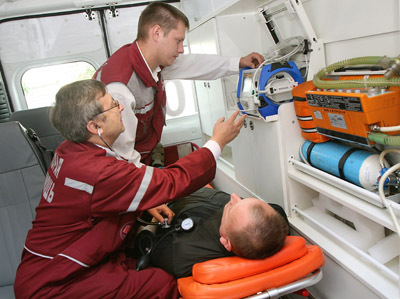Coma is an extreme manifestation of any disease that is associated with loss of consciousness and a severe condition of the patient. Finding a person between life and death is caused by deep inhibitions of processes in the cerebral cortex. It occurs with head injuries, malaria, meningitis, poisoning, hepatitis, diabetes mellitus and a number of other diseases in severe forms. Such conditions are especially dangerous for children.
Types of comas for diabetes mellitus

After some time since the onset of the disease, the human body adapts to some fluctuations in blood sugar levels. However, a very rapid decrease or increase of such an index leads to irreversible processes in the body. Comatose conditions are acute complications of the disease. Depending on the initial development of the clinic, sugar candy is divided into the following types:
- Hyperglycemic - characterized by a strong increase in blood glucose levels. It occurs more often in patients with type 2 diabetes.
- Hypoglycemic. The main reason is a sharp decrease in glucose level.
- Ketoacidotic. Because of a lack of insulin, the body receives a lack of energy through the process of fission of fats. As a result, an excessive amount of ketone bodies( acetone and acids) is formed, which affect the nervous system. As a result, the state of coma develops.
- Hyperlactacidemic. Lactic acid accumulates in tissues and blood during metabolic disturbances and the liver does not manage to remove such volumes from the body. In connection with what develops a coma, which is more rare of all kinds, but causes the most severe conditions of patients.
- Hypersmolar. This kind of coma develops more often in the elderly. It occurs because of disturbed metabolic processes against the background of a very high level of glucose in the blood. Children develop very rarely.
Hyperglycemic coma can develop in both adults and children with diabetes and who have not received appropriate therapy. The reason may be missed another insulin injection, causing a shortage of this protein hormone. In this case, there is a violation of the metabolic processes in the body. The coma can develop regardless of the type of diabetes mellitus, even if the disease has not even been diagnosed. The consequences can be severe.
Causes of

The diagnosis of diabetes is a serious disease and must be treated with full responsibility. After all, for the conduct of a normal lifestyle, it is required to monitor the level of glucose in the blood and comply with all the prescriptions of the doctor. Failure to comply with these requirements can lead to undesirable results. So, to the development of hyperglycemic coma can lead to both the error and forgetfulness of .Here are the reasons why such an unforeseen situation may arise:
- not timely diagnosed,
- untimely introduction of the next dose of insulin,
- consequences of failure of insulin injection,
- incorrectly selected insulin dosage for prescription,
- replacement of insulin species,
- gross neglect of principlesdiabetic diets,
- concomitant serious illnesses or surgery in the presence of diabetes,
- stress.
Symptoms of
The development of hyperglycemic coma occurs gradually - it can be several hours or days. In children, it develops within 24 hours. Her symptoms appear:
- permanent headache,
- severe thirst,
- weakness and drowsiness,
- increase in the daily amount of urine,
- breathing fast,
- nausea and vomiting.

After 12-24 hours after the appearance of the first signs, the condition worsens, apathy appears to all, urine completely ceases to stand out, there is a smell of acetone from the mouth and shortness of breath. The person's breathing becomes frequent with deep and noisy sighs. After a while, there is a violation of consciousness with a subsequent confluence into a coma.
In children, it is easy to determine who. It is problematic to prevent it. For this, parents should keep a constant watch on the child. The signs and consequences of hyperglycemic coma in children are almost the same as in adults. If the adult himself can assess his condition, then the action should be performed by the parents instead of the child.
Symptoms of
In addition to partial or complete impairment of consciousness and the smell of acetone, there are a number of other symptoms that diagnose these conditions:
- redness of the face,
- decrease in muscle tone,
- low blood pressure,
- pulse becomes threadlike and frequent,
- skin becomes cool,
- language is surrounded by a touch of dark brown color.
Emergency
Insulin-dependent patients are aware of the possibility of deterioration. When hyperglycemic coma develops, emergency care should be given immediately. If the patient is conscious, it is required to find out whether he has insulin with him and provide all possible assistance in the injection. If the drug was not with him, then the first aid will be provided by the approaching brigade.

If there is a loss of consciousness, help with hyperglycemic coma is to put the patient in a comfortable position, and head to turn sideways to avoid choking vomit, and to avoid language slippage. Call for an ambulance.
Treatment is performed in a hospital. First aid is to ensure the performance of oxygen therapy. Then the treatment is performed by simultaneous replenishment of the fluid and the introduction of insulin according to special schemes, in the development of which a certain algorithm was used.
Hypoglycemic coma
This kind of coma develops very quickly, so it is especially dangerous for its appearance in children. As a result, it is necessary to act quickly after diagnosis. Some diabetics, who are not long ill, have an individual sensitivity to insulin. It can be very high. Their treatment requires an individual approach, and this must be taken into account when the blood sugar level drops sharply, when first aid is provided.
Comatose conditions for hypoglycemia can be caused by the following reasons:
- of a diabetic, no one taught how to prevent coma when first symptoms appear,
- excessive consumption of alcohol,
- ignorance of its correct dose of insulin or its administration was not accompanied by carbohydrate intake,
- increased dose of tablets,causing the body to produce internal insulin.
Symptoms of hypoglycemia
Primary symptoms of hypoglycemic coma are:
- pale skin,
- increased sweating,
- in the hands and feet sensation of trembling,
- increased heart rate,
- attention can not be concentrated,
- strongly want to eat,
- anxiety,
- nausea.

With these symptoms, you need to eat a few glucose tablets. The first manifestations of hypoglycemic coma in children are similar, they must be drunk with sweet tea, treated with candy or a piece of sugar.
Secondary symptoms indicating the approaching state of hypoglycemic coma:
- severe headache and dizziness,
- sensation of weakness,
- Feeling of fear, reaching a panic,
- a person starts to talk, visual impairments appear,
- trembling in the limbs, convulsions.
These signs in children without providing adequate care lead to seizures of chewing muscles and rapid loss of consciousness. Especially dangerous is the condition of hypoglycemic coma in adults, which occurs after taking a large amount of alcohol. In this case, all the symptoms confirm that the person is just drunk. At this time, alcohol blocks the work of the liver for the synthesis of glucose. There is a decrease in the level of sugar in the blood.
Treatment of patients with diabetes is usually performed by administering insulin before eating. However, there are reasons why there is no way to eat.
In this case, you need to eat a piece of sugar or candy to avoid hypoglycemia.
When performing treatment for patients, it is necessary to learn to distinguish signs of hypoglycemia from hyperglycemia. This is necessary in order not to introduce glucose in place of insulin or vice versa.
Emergency treatment in a hospital begins with an intravenous injection of glucose, and then it is injected with a dropper. In order to prevent cerebral edema, injections of diuretics are made. They also perform oxygen therapy.



